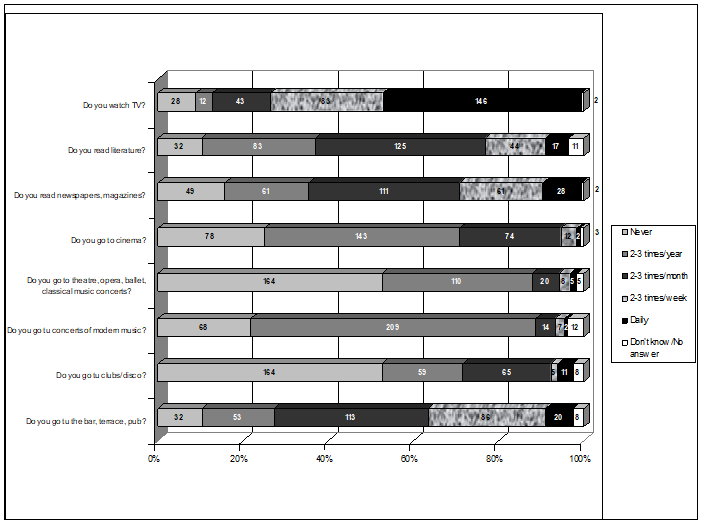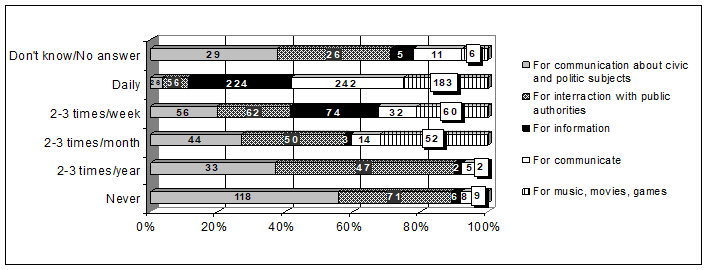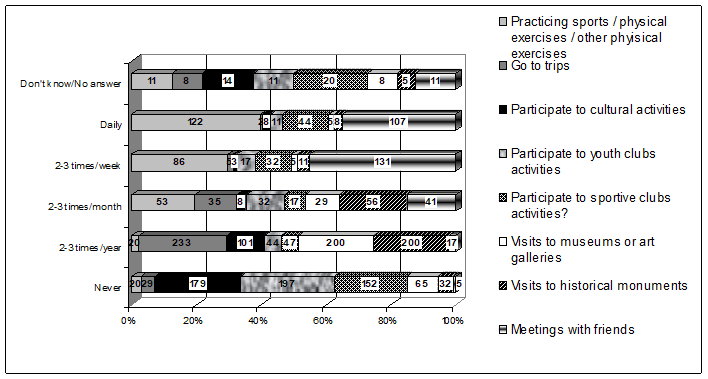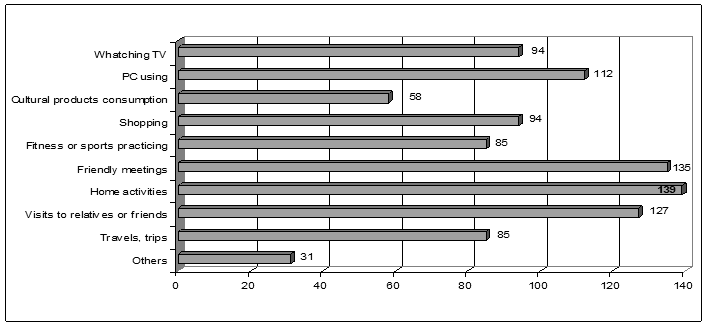Abstract
Education for leisure is a cross-educational activity that can be designed and carried out through various forms. It is a type of education aimed for training and skills management for rational management of leisure and can be transferred into lifelong learning. The research aims to achieve a mapping of ways to leisure among students in order to identify the behavioral characteristics of their free time behaviors. In this regard, we conducted a quantitative research based on questionnaire survey. Specific research objectives are: to identify cultural preferences of the students (OS1); identifying practices leisure agreed students (OS2); describe how students are relating to the traditional practices of leisure consumption practices versus modern - new media (OS3). In this framework it was considered following explanatory paradigm: subculture groups of which the young influence how it identifies ways of spending free time. The unit of analysis is the group of students from the profiles real and human, aged between 19 and 35 years. Recording unit is registered full time for each student. The general conclusion of the research is as follows: ways of leisure among students are influenced by the subculture group to which they belong. Satisfaction regarding life is as an indicator reveals major influence behavior in students’ free time.
Keywords: “Education for leisure”“youth”“recreation”“leisure practices”
Introduction
In the literature, the concept of leisure is defined in a multitude of ways explanatory, among which may be mentioned that conferred by Joffre Dumazedier (1971), author considers leisure as the time in which the “a set of activities which individuals are devotes freely, willingly and gladly, either to rest or to have fun and to meet the aesthetic needs or to enrich information, or to expand and develop social participation voluntary or creative ability after he released the obligations of professional, social and family” (Dumazedier, 1971).
Leisure, in terms of employment, can be subdivided into following types:
Other aspects of the leisure highlight recreation, fun, pleasure for a person to perform certain activities, to implement the expression of a passion, a hobby, like making the move, read, sing, watch a movie, dance, painting, fishing etc. In other words, leisure reflects mainly the work of relaxation and detachment from everyday concerns. It may be higher or lower, depending on how the thinking and aspiration of each person individually, the amount of hours individuals that can have a person after hours of work, and the degree of enlightenment, education, organization capacity, voluntary integration in a specific program access and accommodating to technological novelties, to the family, responsibilities of which are related to a group affiliation, etc. (Menard, 2002; IRES, 2012).
These types of activities, namely entertainment, takes place during free daily and can not be allocated only to specific of weekend or of holidays / vacations, because they can be considered only brief periods of freedom from the daily busy with various constraints zone that can be entitled “work” when it is likely to develop mental and intellectual functions as diverse like creativity, imagination, sense of playfulness, accumulation of new knowledge and skills, vocational skills or affectivity. By them can be deepen communication, socialization with other people, etc., all these elements helping to rebalance the body of the person's psycho-physiological point of view, metabolic and emotional after periods in which, due to not always positive stimulants, these components become deficient. In contemporary society, young people - especially - shows increasing trend of more and more detachment from classical models of leisure activities, and sometimes even direct we are witnessing a reluctance to address previous generations routing their preferences. Young people, however, seem more open-minded and creative, but also to new ways of artistic expression; among them we can mention the use of new technologies as means of production and cultural consumption, new forms and ways of artistic expression (music underground, non-conventional spaces for own manifestation or collectively to new trends, interdisciplinary creations, urban art, art with a social messages etc.) (INCFC, 2014; European Commission, 2007).
Financial resources of this practitioners of the new types of leisure frees them from the family environment or allow the original manifestation in socio-cultural space or limit their access to cultural traditional infrastructure (here comes the role of cultural policies facilitating access to cultural infrastructure) or in terms of free time, that it can be dedicated to the production and consumption of cultural values.
In terms of trends of individualization and tolerance in favor of encouraging positive practices in this direction, youth fluctuates between cultural consumption - individual and in the group -, current studies revealing a balance between isolationist trends in the domestic space due to the use of new technologies and transmission in the public space of their own cultural values and preferences (IRES, 2012).
General objectives
- Establishing the main consumer preferences and cultural practices of leisure agreed by students;
- Identifying trends and consumer preferences cultural profiling among youth student;
- Descriptive analysis of how students relate to the traditional practices of leisure, detrimenting practice modern cultural consumption type (new media).
Problem Statement
The concept of leisure among young people of nowadays, especially students, is one of the main concerns about the weight given to the total available time. Moreover, leisure activities do not constitute a homogeneous system, which is a large amount of various activities and interests..
Research Questions
Analysis, processing and interpretation of the results of this study highlight some general aspects of the issue reflected, among which may be mentioned briefly the following:
- On the needing leisure time, a first aspect is to ensure or satisfy requirements relating to recovery of physical capabilities and mental to resume working process (or learning) and development of needs for each individual, life in different social groups or in the own family;
- The level and share of different activities in leisure time are a result of multiple conditionings and it depends on a number of factors that exert direct or mediated human behavior; among these, the
- Can be added other elements that influence the structure and leisure, such as request regarding intellectual sharpening, intense movement and congestion in big cities and industrial centers (which can influence the body downwards physical strength and mental), increased the unemployment of women (with consequences mainly on family life) etc.;
- Infrastructure of specific leisure is another factor that influences timing of it, but also on the frame / locations where are conducted specific activities.
Questions for the participants regarding this study were focused on issues concerning the concept of leisure, its main activities related to assign a working day and the weekend, within the family or outside it, their hobbies etc. From the responses received some general aspects are such as:
- Differences manifested in the allocated free time practices, according to the environment in which subjects live (urban / rural);
- Differences in terms regarding size of urban centers where students come and differences in the two environments (urban / rural) on activities;
- Differences found at respondents based on sex (female / male);
- Fluctuation in terms of goods consumption or engaging in certain activities of an individual or within a close group;
- Trends in the domestic space-based insulation, predominant use of new communication technologies in social terms;
- Practices of leisure subculture influenced by group etc.;
Purpose of the Study
Research aimed diagnosis and identification of leisure activities among students of the “Valahia” University, Romania..
Research Methods
The survey was based on questionnaire was applied between the months of October and November 2016, on a representative sample for the amount of students from the “Valahia” University. To complete the questionnaire were selected students of the Bachelor and Master programs of the same institution of higher education. The sample comprised 312 students aged 18-35; MPE is ± 3.5% at a confidence level of 95%.
Methods used: bibliographic study, analyzing and adapting information from literature to study, survey-based questionnaire, comparative analysis, graphical representation method, analyzes made punctuallyl
Findings
The first question that respondents asked was regarding the

Going to the movies is an activity that is not of particular interest among contemporary youth, and a possible explanation could be that there are functional locations and infrastructure for such activities, especially in Târgovişte. Given the lack of these objectives or reshaping them took notice lately appearance of several television channels likely to decrease social interest and pleasure of watching movies in the cinema, either individually or in groups, for which developed interest in cinemas 3D type with low number of seats, but with high public interest. Regarding attendance watching the plays, opera performances, concerts of classical music etc., depending on the frequency of participation and their attractiveness, it signals low percentage of participation in these types of events; for example, only 35% of survey respondents participate once or twice a year to them in their free time. Participation in events such as concerts of modern music knows segment higher values represented by those who practice it a few times in a year. Thus, 67% of respondents participate several times annually to such kind of events. The importance given to reading leisure emphasizes that this practice, whether it be the one requested through the various subjects studied or by the additional or specific (driven by interests and personal motivations), occupy a secondary place in the activities preferred by students during free time practices.
May our study reveals results that 40% of respondents say they practice reading once or twice monthly, and newspapers and magazines are also read monthly by 35.5% of respondents. These results demonstrate that periodicals are part of young people's preferences when they will be informed to date on news from one area or another, whether it would pass through the Internet or by consulting their printed formats. If their club attendance is relatively rare, there is a good trend for youth participation, together with the friends group, terraces, bars and cafes, both in everyday leisure and weekend. Using the computer and the Internet in general, both for professional and for entertainment, highlights a number of responses, including:
- Young people use daily computer (fig. 2) or the Internet (fig. 3), programs for various applications and communication (77.5%), information (72%) and for listening to music, watching movies, playing games etc. (more than 58% of the total).
We believe that the use of the personal computer to inform is based on solving the requirements of scientific / professional / didactic as working tools necessary for solving tasks in the classroom or practical courses and seminars on specialties where they are enrolled, but also for watch and / or download some documentation contents of journals, articles, e-books etc.;
- In a similar amount of time, most subjects using various applications for social networks and communication (e.g.: Facebook, Linkedin, Twitter, Yahoo Messenger, etc.), similarly as above, for watching movies, listening songs music for various games, to use e-mail, visit the forums or blogs etc.;
- Student youth is the age group that has the highest degree of interest in using advanced technology, it making easier for them for socializing with others;
- There is no or low use (only 8.3%) of the young people questioned of the media on topics of civic, political socialization through the same networks. The conclusion is that young people has a little or no interest for political life of their country or others. However, other respondents are interested, to a certain extent, for decisions taken both by local authorities and the central ones.


Analysis of activities performed during open daily (fig. 4) highlights other issues reported, among which are to be mentioned the following:
- Recreation spent with friends every day or two / three times a week (76%) qualifies leisure of youth at the expense of visiting historical monuments, museums and other cultural-historical sights (visit being accomplished largely two / three times a year); arguments as disinterest, transportation / traveling to these, lack of information, limited offer etc.
- There is also the important ways of leisure, taking part in sport activities, performing other exercises (over 66%). From this point of view, it may be revealed that there are differences between the practices of leisure of youth by rural / urban, and the size of settlements from which the respondents come (infrastructure leadership profile - stadiums, halls, clubs, sports , swimming pools, bike lanes, etc.);
- The proportion of young people participating in the activities of associations and youth clubs, and those who participate in manifestations of cultural organizations is relatively low, whereas over 63% of them say they do not do this ever, and most of those who participate in this type of practice rarely do - 2-3 times a year;
- Trips made, although rare (two to three times a year) outside the village, is another way of leisure, relatively common among people in general and youth in particular, almost 75% of respondents having such practices.

Recreational methods practiced on the weekend for leisure (fig. 5) stands out as frequently practiced activities the household (44.5%), followed by meetings with friends (43.2%) and visits mainly to relatives and friends (40.7%). Roughly equal proportions have using the computer, shopping, watching TV, practicing sports, fitness, and travel or excursions. The residence of the students takes with it some differences in terms of time allocated to activities such as socializing with friends, in favor of rural areas, so the budget allotted time, and their frequency. In this regard, during the week if time dedicated social activities not significant differences in rural youth weekend gives them more time to their peers in urban areas. One explanation is that cities offer more diverse opportunities than those in rural areas in terms of leisure; for example, those in cities have more opportunities to watch shows, going to concerts, visits to museums, exhibitions, to practice sports, to walk in parks etc.

When asked “Who usually spend your free time?”, answers of students are directed mainly to the family, followed by friends or colleagues. A very small percentage (3.8%) responded that they spend time alone. As mentioned in the above question, the most plausible explanation is youth loneliness due to the influence of information technology at the expense of socialization itself, manifested through meetings between people as such.
In terms of leisure time enjoyed responses showed that students are divided relatively equally regarding the number of hours allocated to leisure. Looking at the percentages obtained in free time available to them youth have a number of practices that do not concern just their passions, their favorite occupations, but are engaged mainly in the professional activity (the kind of preparation for school, reading, writing etc.) or family ones (childcare, cooking, gardening and other household work).
Leisure practices are important components of lifestyles that young people adopt. Results on how the leisure and the impact that the economic factor has on it highlights the fact that youth are pretty much affected in choosing their forms, but in the intensity with which they consume resources for leisure or cultural products (over 66% of young people interviewed opinion that money determines weights in various forms of leisure, and here we consider the financial contribution for holidays or vacations. In this regards, can advance the hypothesis that a good financial budget of the person / family determines a rich offer of resource consumption / leisure products.
Among the activities that young people practice particularly in leisure there are also trips to the mountains or the sea, though it noted a 26% of them who do not make such voyages, confirming the above hypothesis, the share of income of each people most likely relied on low incomes being, on the one hand, and on the other hand that they are saving money for other necessities personal / family at the expense of their spending for holidays / vacations.
In this context, it is found that 37% of students have never traveled for tourism and leisure outside Romania (almost 60% of respondents do not practice these activities, whether for financial reasons or because they choose as a travel destination own country), 21% once and 25% have traveled several times.
Conclusion
Starting from consulting a specialist literature and comprehensive in summarizing certain steps of sociological significant focused on the study of cultural practices and leisure (both at global or European and national or local), the present study aims to take into the light importance that should be given in Romania for carrying of researches to foster education for good practice in this area, focusing on subgroups of the population - in this case students. From analyzing the main leisure activities among students, according to the results obtained in the course of the present research, we can formulate the following general conclusions:
- The last two decades, the expansion of the Internet and information technology in general, has generated significant changes in terms of leisure young people, especially their behavioral practices of social-educational type;
- Leisure activities dedicated emphasize the understanding of how the so-called new media cultural influences behavior and how it interferes with religious or traditional cultural practices. When talking about new media is envisaged a number of changes, with obvious impact on the cultural life of the media production benefited in recent decades: the emergence of virtual reality, new ways of communication, socialization, production and distribution through the information technology and, more recently, various associated equipment, as well as actual changes that the media has known during their development; in this respect, is trying highlighting how new technologies, which is directly exposed to the younger generation, shapes the attitudes, values and hence cultural behaviors;
- It is to be observed also that young people aged 18-35 are most numerous consumers of technical and digital information;
- The main activities of students, both during the free daily and weekend are: watching TV (for movies mainly), listening to music, meeting and socialize with relatives, performing household activities, visiting relatives or friends, but also a great dealing of time using a dedicated to the computer, excursions and trips etc.;
- Among young hobbies are traveling, sports and reading and using computers.
The overall conclusion of the present research is that the means of leisure among students are influenced by the subculture group to which they belong. Satisfaction with their lives is as the primary influence reveals their leisure behavior.
So, assuming that led to this study, at least for the students participating in the questionnaire applied, is confirmed, which requires to be considered new research likely to deepen the changes taking place in the concerns of young student at both local and national or international, according to trends increasingly more obvious to new, both in terms of education and more positive in terms of leisure;
Acknowledgments
This article is the exclusive contribution of the authors, without other contributions from institutions or individuals.
References
- Cucoș, C. (2002). Timp și temporalitate în educație. Elemente pentru un management al timpului școlar [Time and temporality in education. Elements for a scholar time management]. Iasi: Editura Polirom.
- Dumazedier, J. (1971). Free time, it’s fonctions and it’s social-economic condition (Timpul liber, funcţiunile şi condiţia lui social-economică). In I. Drăgan & I. Almaş, (eds.), Sociologie franceză contemporană [French contemporary sociology] (pp. 1-30). București: Editura Politică, [1962].
- European Commission, (2007). Special Eurobarometer 278 - European Cultural Values. Retrieved from http://ec.europa.eu/public_opinion/archives/ebs/ebs_278_en.pdf
- Institutul Naţional pentru Cercetare şi Formare Culturală (INCFC), (2014). Strategia sectorială în domeniul culturii şi patrimoniului național pentru perioada 2014-2020 [Sectoral strategy in the domains of Culture and National Heritage for 2014-2020]. Retrieved from http://www.culturadata.ro/wp-content/uploads/2014/05/STRATEGIA_SECTORIALA.pdf.
- Institutul Român pentru Evaluare și Strategie (IRES), (2012). Barometru de opinie publică pentru tineret, 2012. [Barometer of Public Opinion of Youth, 2012]. Retrieved from http://www.ccsmures.ro/wp-content/uploads/2012/12/IRES_ANST_Barometru-tineret_Raport-grafic-si-interpretari.pdf
- Menard, J-D. (2002). Cum să ne administrăm timpul [How to administrate our time]. Iasi: Editura Polirom.
Copyright information

This work is licensed under a Creative Commons Attribution-NonCommercial-NoDerivatives 4.0 International License.
About this article
Publication Date
30 July 2017
Article Doi
eBook ISBN
978-1-80296-026-6
Publisher
Future Academy
Volume
27
Print ISBN (optional)
-
Edition Number
1st Edition
Pages
1-893
Subjects
Teacher training, teaching, teaching skills, teaching techniques,moral purpose of education, social purpose of education, counselling psychology
Cite this article as:
Pehoiu, G., Anghel, A., & Sencovici, M. (2017). Leisure Education Among Students. In A. Sandu, T. Ciulei, & A. Frunza (Eds.), Multidimensional Education and Professional Development: Ethical Values, vol 27. European Proceedings of Social and Behavioural Sciences (pp. 559-568). Future Academy. https://doi.org/10.15405/epsbs.2017.07.03.66
